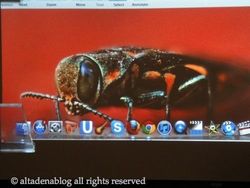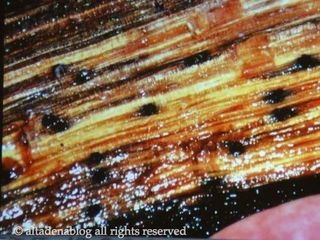Windstorm of 2011 aided the spread of pests

by Laura Monteros
The shot hole borer is a helpful little creature, in its proper place. But in Southern California, it’s an insidious, uncontrollable tree-killing pest.
“It’s good, but not for us,” Frank McDonough, botanical information consultant at the Los Angeles County Arboretum, said Wednesday night, April 24, at the Altadena Community Center. McDonough was the guest speaker as part of Altadena Heritage's “Heritage of Abundance” series, which looked at the shot hold borer and its kin, who are becoming an increasing danger to local trees.
So what’s good about it? It seems the critter clears out dying flora during periods of global warming to prepare the land so the next biome can come in more quickly. “It makes a nice, smooth, easy transition,” McDonough said.
But in Southern California, where it's virulent, there is currently no way to control or prevent it. It’s such a dangerous dude that even the research center, Eskalen Lab at UC Riverside, won’t keep it on hand and has moved its research to the Arboretum. The bug bores deeper into the tree than most beetles —1 ½ to 2 inches— which protects it from birds. It does not have to emerge from the tunnels to mate. No biological parasite or insecticide has been discovered that can kill it and sonic waves are ineffective.
Accommodating fungus
Dan Berry, nursery manager at The Huntington Library and Botanical Gardens in San Marino, added, “The problem with this bug is that it is very smart, very lazy, and very efficient.” It travels with two types of food, fusarium and graphyllium fungus (hence the moniker “polyphagous”) and it sometimes uses existing galleries (the little tunnels bored into trees) to breed. The fungus is very accommodating, putting the tastiest morsels where it’s easiest for the beetle to harvest, and thus spreading itself throughout multiple hosts. It’s this combination of fungus—especially the graphyllium—and wood damage that kills the tree. The Huntington is working with an East Coast company to develop a system that will kill the fungus and the animal.
Less than a tenth of an inch long, the tiny insect is not easy to spot. Its entry hole is about the size of buckshot surrounded by a puff of sawdust around it and usually a sticky ooze. It prefers smooth-barked trees, but it will enter rough-barked trees, where it’s harder to identify the holes. It loves wisteria, a fact that has the folks in Sierra Madre worried.
First noticed in Los Angeles County attacking commercial avocado trees in El Monte—it attacks about 50 percent of avocado species—the beetle has moved throughout the Los Angeles basin, mostly from Long Beach to the mountains and throughout the San Gabriel Valley. Both Florida and Israel have similar infestations.
Mysterious beetle
This version of a shot hole borer is a mysterious little guy. “We’re not sure what it is,” Berry said. “It’s an Ambrosia beetle of some sort.” They’re not sure where it came from, either. It likely entered through the ports, either from Southeast Asia or Northern Africa. Berry said it’s difficult to categorize the beetle, and it may be a new species entirely.
“Almost on a weekly basis, we uncover a new thing about it,” he said, and hypotheses are routinely overturned. The insect was originally thought to be the kind that only attacks tea plants in Sri Lanka. It was thought to be photophobic (i.e. afraid of light, like cockroaches), until researchers found the bodies of scores of bugs that had emerged from their containers and swarmed to windows. It was thought that wood chips would not carry the pest, but it has been found to live in chips as small as 1 inch. Fusarium was considered to be the more dangerous fungus, but it was discovered that graphyllium does more damage.
he infestation was aggravated by the windstorms of 2011. Fallen branches were piled up, allowing the pests spread out to new territory. For instance, the sycamores in Pasadena Glen have been devastated, because the City of Pasadena piled limbs in a holding yard behind the neighborhood?
“We’ve never seen a pest like this,” McDonough said, and Berry added that some scientists think it will eventually burn itself out.
Not the only pest
McDonough spoke for a few minutes about the Gold Spotted Oak Borer. This species of shot hole borer is not as dangerous a pest as the Ambrosia beetle and so far has not appeared in Los Angeles County, but there are infestations in San Diego and Riverside counties. It’s been in Southern California for about eight years and attacks Coast live oaks.
It burrows just under the bark of a tree, and can eventually girdle the tree. It is most attracted to trees that are already stressed, usually by compacted soil, but once these pests infest a tree, they can spread to healthy trees.
The entry hole is about 1/8 inch in diameter, and the colorful beetle is about a penny-width long. It’s native to Eastern Arizona, West Texas, and Northern Mexico.
What can be done? Not much
One of the problems with controlling the beetles, McDonough said, is that since 9/11, much of the funding that had been used for interdiction of wood pests had been transferred to anti-terrorism, even though in his opinion an agriculture infestation would cause more damage. The hope is that the avocado industry will successfully lobby for state funds for research and control. If it appears in two counties, it’s possible that the state will enact some nursery trade restrictions as well.
Are there preventative measures? the audience wanted to know.
“Not really,” McDonough said with a sardonic smile. “Just don’t let the city dump cut wood from storms behind your house.” He and Berry did give some suggestions to mitigate the damage:
- Do not dispose of the trimmings in the trash or landfills; trees that grow around the landfills can become infected
- Cut back on watering trees, because fungus likes dampness
- Cut limbs back to where you don’t see a problem anymore
- Know that tools used to trim trees can spread the fungus
- Chip the wood, compost the chips and dig them into the ground
- Don’t spread firewood; leave it on the property
- Burn the wood (if it is not sprayed)
- Don’t plant susceptible trees.






